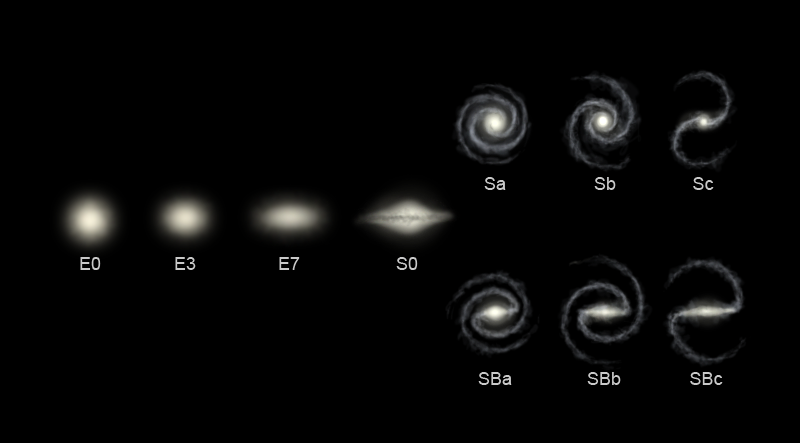Galaxies can have as few as a couple of millions stars or as many as a trillion. They come in three basic shapes, now called the ‘Hubble sequence’ after the American astronomer Edwin Hubble: spiral with a round center, barred spiral (with an elongated center), and elliptical with a more or less uniform distribution of stars and no visible arms. By this definition, our own Milky Way is a barred spiral.

Hubble sequence by Ville Koisinen: elliptical galaxies on the left, spirals top right, barred spirals bottom right.
There are two interesting puzzles regarding galaxy formation. One is why there are so many ‘dwarf’ galaxies containing far fewer stars than would be expected. The other is why galaxies come in these distinct shapes.
To answer the first question, Fabio Governato from the University of Washington and his international team ran simulations of galaxy formation on supercomputers. After millions of hours of computing time (the equivalent of several centuries), they uncovered evidence that it was the explosion of massive new stars into supernovas that was limiting the number of stars in those galaxies. As the stars exploded, the blast waves swept away huge amounts of gas that could have been made into other stars.
Governato’s results are also consistent with the cold dark matter theory, which, among other things, states that galaxies form within haloes of dark matter.
This brings us to the second question of why galaxies have the particular shapes they have.
Andrew Benson of the California Institute of Technology (Caltech) and Nick Devereux of Embry-Riddle University in Arizona postulated that the nascent galaxies merged in different ways with their surrounding haloes of dark matter. The final galactic shape depended on the number and type of these mergers. For example, the barred spiral of our own Milky Way would have resulted from some minor collisions with its halo, followed by the collapsing of the inner disk into a bar.
To test their hypothesis, Benson and Devereux used the infrared Two Micron All Sky Survey (2MASS) to track the formation of galaxies since the Big Bang. After crunching the numbers, they found that their computations could account for both the shape and relative numbers of galaxies.
No comments:
Post a Comment